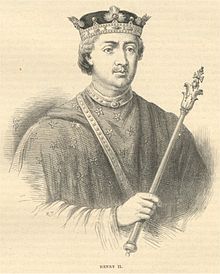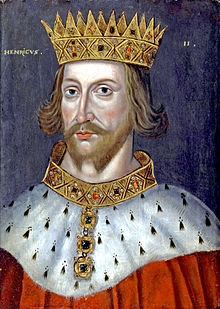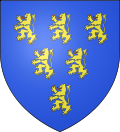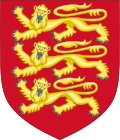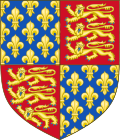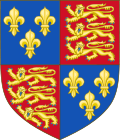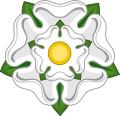- Henry II of England
-
"Henry Plantagenet" redirects here. For others, see Category:House of Plantagenet.
Henry II 
King of England (more...) Reign 25 October 1154 – 6 July 1189 Coronation 19 December 1154 Predecessor Stephen Successor Richard I Junior king Henry the Young King Spouse Eleanor of Aquitaine Issue William IX, Count of Poitiers
Henry the Young King
Richard I of England
Geoffrey II, Duke of Brittany
Matilda, Duchess of Saxony
Eleanor, Queen of Castile
Joan, Queen of Sicily and Countess of Toulouse
John
Geoffrey, Archbishop of York (illegitimate)
William Longespée, 3rd Earl of Salisbury (illegitimate)
Morgan, Bishop-Elect of Durham (illegitimate)House House of Plantagenet Father Geoffrey V, Count of Anjou Mother Matilda of England Born 5 March 1133
Le Mans, FranceDied 6 July 1189 (aged 56)
Chinon, FranceBurial Fontevraud Abbey, France Henry II (5 March 1133 – 6 July 1189) ruled as King of England (1154–1189), Count of Anjou, Count of Maine, Duke of Normandy, Duke of Aquitaine, Duke of Gascony, Count of Nantes, Lord of Ireland and, at various times, controlled parts of Wales, Scotland and western France. Henry, the great-grandson of William the Conqueror, was the first of the House of Plantagenet to rule England. Henry was the first to use the title "King of England" (as opposed to "King of the English").
He is known as Henry Curtmantle or Curtmantel (French: Henri Court-manteau) and Henry Fitz-Empress.
Contents
Early life and descent
Henry II was born in Le Mans, France, on 5 March 1133.[1] His father, Geoffrey Plantagenet, Count of Anjou,[2] son of Fulk of Jerusalem, was also Count of Maine. His mother, Empress Matilda, was a claimant to the English throne as the daughter of King Henry I (reigned 1100–1135). His own claim to the throne was strengthened by his descent from both the English Saxon kings and the kings of Scotland through his maternal grandmother Matilda of Scotland, whose father was Malcolm III of Scotland and whose mother was Margaret of Wessex (St. Margaret of Scotland), granddaughter of Edmund Ironside.
He spent his childhood in his father's land of Anjou. At the age of nine, Robert of Gloucester took him to England, where he received education from Master Matthew at Bristol, with the assistance of Adelard of Bath and possibly Geoffrey of Monmouth. In 1144, he was returned to Normandy where his education was continued by William of Conches. Later, in 1147 at the age of 14, without either of his parents' knowledge, he hired a band of mercenaries and sailed to England. He failed to take two minor castles and then took refuge with his mother. His mother bade him return to Normandy, but Henry did not have enough money to pay for a boat back or to pay off his mercenaries and his mother did not have the funds. He decided to ask King Stephen for money. Surprisingly, Stephen gave him the money and sent him on his way.[3]
Marriage and legitimate children
On 18 May 1152, at Poitiers,[4] at the age of 19, Henry married Eleanor of Aquitaine. The wedding was "without the pomp or ceremony that befitted their rank,"[5] partly because Eleanor's prior marriage to Louis VII of France had been annulled only two months previously. Their relationship, always stormy, eventually disintegrated: after Eleanor encouraged her children to rebel against their father in 1173, Henry had her placed under house arrest, where she remained for fifteen years.[6]
Henry and Eleanor had eight children: William, Henry, Richard, Geoffrey, John, Matilda, Eleanor, and Joan. William died in infancy. In the custom of the Capetian Kings of France, whose heirs apparent were crowned during their own lifetime in order to avoid succession disputes, Henry was crowned as joint king when he came of age. However, because he was never king in his own right, he is known to history as "Henry the Young King", rather than Henry III. As the king's sons matured, it was expected that Henry would inherit the throne from his father, Richard his mother's possessions, Geoffrey would have Brittany through marriage, and John would be Lord of Ireland. However, fate would ultimately decide much differently.
It has been suggested by John Speed's 1611 book, History of Great Britain, that another son, Philip, was born to the couple. Speed's sources no longer exist, but Philip would presumably have died in early infancy.[7]
Appearance
 Penny of Henry II
Penny of Henry II
Several sources record Henry's appearance. They all agree that he was very strong, energetic and surpassed his peers athletically.
...he was strongly built, with a large, leonine head, freckle fiery face and red hair cut short. His eyes were grey and we are told that his voice was harsh and cracked, possibly because of the amount of open-air exercise he took. He would walk or ride until his attendants and courtiers were worn out and his feet and legs were covered with blisters and sores... He would perform all athletic feats.—John Harvey (Modern)[8]...the lord king has been red-haired so far, except that the coming of old age and grey hair has altered that colour somewhat. His height is medium, so that neither does he appear great among the small, nor yet does he seem small among the great... curved legs, a horseman's shins, broad chest, and a boxer's arms all announce him as a man strong, agile and bold... he never sits, unless riding a horse or eating... In a single day, if necessary, he can run through four or five day-marches and, thus foiling the plots of his enemies, frequently mocks their plots with surprise sudden arrivals... Always are in his hands bow, sword, spear and arrow, unless he be in council or in books.—Peter of Blois (Contemporary)A man of reddish, freckled complexion, with a large, round head, grey eyes that glowed fiercely and grew bloodshot in anger, a fiery countenance and a harsh, cracked voice. His neck was poked forward slightly from his shoulders, his chest was broad and square, his arms strong and powerful. His body was stocky, with a pronounced tendency toward fatness, due to nature rather than self-indulgence – which he tempered with exercise.—Gerald of Wales (Contemporary)Character
Like his grandfather, Henry I of England, Henry II had an outstanding knowledge of the law. A talented linguist and excellent Latin speaker, he would sit on councils in person whenever possible. He dressed casually except when tradition dictated otherwise and ate a sparing diet.[8]
According to contemporary chronicler of court gossip Walter Map, Henry was modest and mixed with all classes easily. "He does not take upon himself to think high thoughts, his tongue never swells with elated language; he does not magnify himself as more than man".[9] His generosity was well-known and he employed a Templar to distribute one tenth of all the food brought to the royal court amongst his poorest subjects.
Henry also had a good sense of humour and was never upset at being the butt of the joke. Once while he sat sulking and occupying himself with needlework, a courtier suggested that such behaviour was to be expected from a descendant of the bastard son of a tanner's daughter (referring to his great-grandfather William the Conqueror being the son of Herleva, daughter of Fulbert a tanner from the Norman town of Falaise). The king rocked with laughter and even explained the joke to those who did not immediately grasp it.[10]
"His memory was exceptional: he never failed to recognise a man he had once seen, nor to remember anything which might be of use. More deeply learned than any king of his time in the western world".[8]
In contrast, the king's temper has been written about. His actions against Thomas Becket are evidence of his blinding temper, along with his conflict with William I of Scotland.[11]
Construction of an empire
Main article: Angevin EmpireHenry's claims by blood and marriage
Henry's father, Geoffrey Plantagenet, held rich lands as a vassal from Louis VII of France. Maine and Anjou were therefore Henry's by birthright, amongst other lands in Western France.[5] By maternal claim, Normandy was also to be his. From a contemporary perspective, however, the most notable inheritance Henry received from his mother was a claim to the English throne. Granddaughter of William the Conqueror, Empress Matilda was to be queen regnant of England, but her throne was usurped by her cousin, Stephen of England. Henry's efforts to restore the royal line to his own family would create a dynasty spanning three centuries and thirteen kings.
Henry's marriage to Eleanor of Aquitaine placed him firmly in the ascendancy.[5] His plentiful lands were added to his new wife's possessions, giving him control of Aquitaine and Gascony. The riches of the markets and vineyards in these regions, combined with Henry's already plentiful holdings, made Henry the most powerful vassal in France.
Taking the English throne
Realising Henry's royal ambition was far from easily fulfilled; his mother had been pushing her claim for the crown for several years to no avail, finally retiring in 1147. It was 1147 when Henry had accompanied Matilda on an invasion of England. It soon failed due to lack of preparation,[5] but it made him determined that England was his mother's right, and so his own. He returned to England again between 1149 and 1150. On 22 May 1149 he was knighted by King David I of Scotland, his great uncle, at Carlisle.[12]
On 7 September 1151, Henry's father died and he inherited all his lands including Anjou, Maine and Normandy. Early in January 1153, just months after his wedding, he crossed the Channel one more time. His fleet was 36 ships strong, transporting a force of 3,000 footmen and 140 horses.[13] Sources dispute whether he landed at Dorset or Hampshire, but it is known he entered a small village church. It was 6 January and the locals were observing the Festival of the Three Kings. The correlation between the festivities and Henry's arrival was not lost on them. "Ecce advenit dominator Dominus, et regnum in manu ejus", they exclaimed as the introit for their feast, "Behold the Lord the ruler cometh, and the Kingdom in his hand."[12]
Henry moved quickly and within the year he had secured his right to succession via the Treaty of Wallingford with Stephen of England. He was now, for all intents and purposes, in control of England. When Stephen died in October 1154, it was only a matter of time until Henry's treaty would bear fruit, and the quest that began with his mother would be ended. On 19 December 1154 he was crowned in Westminster Abbey, "By The Grace Of God, Henry II, King Of England".[12] He was thus the first to be crowned "King of England", as opposed to "King of the English."[14] Henry, a vassal of Louis VII, was now more powerful than the French king himself. Henry used the title Rex Angliae, Dux Normaniae et Aquitaniae et Comes Andigaviae (King of England, Duke of Normandy and Aquitaine, Count of Anjou).[15]
Lordship over Ireland
See also: Norman invasion of IrelandShortly after his coronation, Henry sent an embassy to the newly elected Pope Adrian IV (who was himself from England). Led by Bishop Arnold of Lisieux, the group of clerics requested authorisation for Henry to invade Ireland. Some historians suggest that this resulted in the papal bull Laudabiliter. Whether this donation is genuine or not, Edmund Curtis says, is one of "the great questions of history."[16] It is possible Henry acted under the influence of a "Canterbury plot," in which English ecclesiastics strove to dominate the Irish church.[17] However, Henry may have simply intended to secure Ireland as a lordship for his younger brother William.
William died soon after the plan was hatched and Ireland was ignored. It was not until 1166 that it came to the surface again. In that year, Diarmait Mac Murchada, King of Leinster, was driven from his lands by Rory O'Conor, the High King of Ireland. Diarmait followed Henry to Aquitaine, seeking an audience. Henry promised to help him reassert control and made footmen, knights and nobles available for the cause. Their leader was a Welsh Norman, Richard de Clare, 2nd Earl of Pembroke, nicknamed "Strongbow". In exchange for his loyalty, Diarmait offered Earl Richard his daughter Aoife (Eva) in marriage and made him heir to his kingdom.
The Normans quickly restored Diarmait to his kingdom, but it soon became apparent that Henry had not helped purely out of kindness, and was now worried that Strongbow and his Cambro-Norman supporters would become independent of him. In 1171 Henry arrived from France with an army and declared himself "Lord of Ireland". All of the Normans, along with many Irish princes, took oaths of homage to Henry by November, and he left after six months. He never returned, but in 1177 he named his youngest son, Prince John, as Lord of Ireland.
This process started 800 years of English overlordship on the island. At the Synod of Cashel in 1172 Church reforms were introduced. The 1175 Treaty of Windsor was agreed with King Rory O'Conor, but soon broke down.
Consolidation in Scotland
In 1174, a rebellion spearheaded by his own sons was not Henry's biggest problem. An invasion force from Scotland, led by their king, William the Lion, was advancing from the North. To make matters worse, a Flemish armada was sailing for England, just days from landing. It seemed likely that the king's rapid growth was to be checked.[1]
Henry saw his predicament as a sign from God, that his treatment of Becket would be rewarded with defeat. He immediately did penance at Canterbury[1] for the Archbishop's fate and events took a turn for the better.
The hostile armada dispersed in the English Channel and headed back for the continent. Henry had avoided a Flemish invasion, but Scottish invaders were still raiding in the North. Henry sent his troops to meet the Scots at Alnwick, where the English scored a devastating victory. William was captured in the chaos, and within months all the problem fortresses had been torn down.[which?] Southern Scotland was now completely dominated by Henry, another fief in his Angevin Empire, that now stretched from the Solway Firth almost to the Mediterranean and from the Somme to the Pyrenees. By the end of this crisis, and his sons' revolt, the king was "left stronger than ever before".[18]
Domestic policy
Dominating nobles
During Stephen's reign, the barons in England had undermined Royal authority. Rebel castles were one problem, nobles avoiding military service was another. The new king immediately moved against the illegal fortresses that had sprung up during Stephen's reign, having them torn down.
To counter the problem of avoiding military service, scutage became common. This tax, which Henry's barons paid in lieu of military service, allowed the king to hire mercenaries. These hired troops were used to great effect by both Henry and his son Richard, and by 1159 the tax was central to the king's army and his authority over vassals.
Legal reform
Henry II's reign saw the establishment of Royal Magistrate courts.[19] This allowed court officials under authority of the Crown to adjudicate local disputes, reducing the workload on Royal courts proper and delivering justice with greater efficiency.
Henry also worked to make the legal system fairer. Trial by ordeal and trial by combat were still common in the 12th century. By the Assize of Clarendon in 1166, supplemented a decade later by the Assize of Northampton, a precursor to trial by jury was implemented. However, this group of "twelve lawful men," as the Assize commonly refers to it, provided a service more similar to a grand jury, alerting court officials to matters suitable for prosecution. Despite these reforms, trial by ordeal continued until the Fourth Council of the Lateran forbade the participation of the clergy in 1215 and trial by combat was still legal in England until 1819, albeit only rarely resorted to after the twelfth century. Nevertheless, Henry's support of juries was a great contribution to the country's social history and allowed for a smoother transition from ordeal to jury than was managed in other European nations where trial by inquisition and even torture became commonplace.
Religious policy
Main article: Becket controversyStrengthening royal control over the church
In the tradition of Norman kings, Henry II was keen to have secular law predominate over the law of the church. The clergy had a free hand, and were not required to obey laws of the land that conflicted with the governance of the church. Henry wanted the laws of the land to be obeyed by all, clergy and laity alike. At Clarendon Palace on 30 January 1164, the king set out sixteen constitutions, aimed at decreasing ecclesiastical interference from Rome. Secular courts would also have jurisdiction over clerical trials and disputes. Henry's authority guaranteed him majority support, but Thomas Becket, the newly appointed Archbishop of Canterbury, refused to ratify the proposals.
Henry was characteristically stubborn, and on 8 October 1164, he called archbishop Thomas Becket before the Royal Council. Becket, however, had fled to France and was under the protection of Henry's rival, Louis VII of France.
The king continued doggedly in his pursuit of control over his clerics. By 1170, the pope was considering excommunicating all of Britain. Only Henry's agreement that Becket could return to England without penalty prevented this fate.
Murder of Thomas Becket
"What miserable drones and traitors have I nurtured and promoted in my household who let their lord be treated with such shameful contempt by a low-born cleric!" were the words which sparked the darkest event in Henry's religious wranglings. This speech has translated into legend in the form of "Will no one rid me of this turbulent priest?"—a provocative statement which would perhaps have been just as riling to the knights and barons of his household at whom it was aimed as his actual words. Bitter at his old friend Becket, constantly thwarting his clerical constitutions, the king shouted in anger but possibly not with intent. However, four of Henry's knights, Reginald Fitzurse, Hugh de Morville (the Lord of Westmorland), William de Tracy, and Richard le Breton overheard their king's cries and decided to act on his words.
On 29 December 1170, they entered Canterbury Cathedral, finding Becket near the stairs to the crypt. They beat down the Archbishop, killing him with several blows. Becket's brains were scattered upon the ground with the words; "Let us go, this fellow will not be getting up again". Whatever the rights and wrongs, it certainly tainted Henry's later reign. For the remaining 20 years of his rule, he would personally regret the death of a man who "in happier times...had been a friend".[20]
Just three years later, Becket was canonised and revered as a martyr against secular interference in God's church; Pope Alexander III had declared Becket a saint. Plantagenet historian John Harvey believes "The martyrdom of Thomas Becket was a martyrdom which he had repeatedly gone out of his way to seek...one cannot but feel sympathy towards Henry".[20] Wherever the true intent and blame lie, it was yet another sacrifice to the ongoing war between church and state.
The Angevin Curse
Civil war and rebellion
Main article: Revolt of 1173–1174“ It is the common fate of sons to be misunderstood by their fathers, and of fathers to be unloved of their sons, but it has been the particular bane of the English throne.[21] ” Henry's attempts to divide his lands amongst his numerous ambitious children, combined with his reluctance to cede his own power and entrust them with any real responsibility, fractured his family. In 1173, Young Henry and Richard revolted against their father, hoping to secure the power and lands they had been promised. While both Young Henry and Richard were relatively strong in France, they still lacked the manpower and experience to trouble their father unduly. The king crushed this first rebellion and exacted punishment. Richard, for example, lost half of the revenue allowed to him as Count of Poitou.[22]
In 1182, the Plantagenet children's aggression turned inward. Young Henry, Richard and Geoffrey all began fighting each other for their father's possessions on the continent. The situation was exacerbated by French rebels and the king of France, Philip Augustus. This was the most serious threat to come from within the family yet, and the king faced the dynastic tragedy of civil war. However, on 11 June 1183, Henry the Young King died. The uprising, which had been built around the prince, promptly collapsed and the remaining brothers returned to their individual lands. Henry quickly occupied the rebel region of Angoulême to keep the peace.[22]
The final battle between Henry's sons came in 1184. Geoffrey of Brittany and John of Ireland, the youngest brothers, had been promised Aquitaine, which belonged to now eldest brother Richard.[22] Geoffrey and John invaded but Richard, who was an accomplished military commander with over 10 years of experience by this time, expelled his brothers. The brothers would never again face each other in combat; Geoffrey died two years later, leaving only Richard and John.
Death and succession
The final thorn in Henry's side would be an alliance between his eldest surviving son, Richard, and his greatest rival, Philip Augustus. John had become Henry's favourite son and Richard had begun to fear he was being written out of the king's inheritance.[22] In summer 1189, Richard and Philip invaded Henry's heartland of power, Anjou. The unlikely allies took northwest Touraine, attacked Le Mans and overran Maine and Tours. Defeated, Henry II met his opponents and agreed to all their demands, including paying homage to Philip for all his French possessions.
Weak, ill, and deserted by all but an illegitimate son, Geoffrey, Henry died at Chinon on 6 July 1189. Chroniclers record him saying "My other sons are the real bastards. This is the one who's proved himself legitimate."[23] The victorious Prince Richard later paid his respects to Henry's corpse as it travelled to Fontevraud Abbey, upon which, according to Roger of Wendover, 'blood flowed from the nostrils of the deceased, as if...indignant at the presence of the one who was believed to have caused his death'. The Prince, Henry's eldest surviving son and conqueror, was crowned "by the grace of God, King Richard I of England" at Westminster on 1 September 1189.
Ancestry
Ancestors of Henry II of England 16. Geoffrey, Count of Gâtinais 8. Fulk IV of Anjou 17. Ermengarde of Anjou 4. Fulk V of Anjou 18. Simon I de Montfort 9. Bertrade de Montfort 19. Agnes, Countess of Evreux 2. Geoffrey V of Anjou 20. John de Beaugency 10. Elias I of Maine 21. Paula of Maine 5. Ermengarde of Maine 22. Gervais, Lord of Château-du-Loir 11. Matilda of Château-du-Loir 23. Éremburge 1. Henry II of England 24. Robert I of Normandy 12. William I of England 25. Herleva of Falaise 6. Henry I of England 26. Baldwin V, Count of Flanders 13. Matilda of Flanders 27. Adèle of France 3. Empress Matilda 28. Duncan I of Scotland 14. Malcolm III of Scotland 29. Suthen 7. Matilda of Scotland 30. Edward the Exile 15. Margaret of Scotland 31. Agatha Descendants
For a list of Henry's male-line descendants, see List of members of the House of Plantagenet.
Henry had a number of mistresses, including Rosamund Clifford. One of the daughters of Eleanor's ex-husband Louis VII, Alys, originally sent to Henry's court to marry Richard, was also said to be Henry's mistress.
Henry also had illegitimate children. While they were not valid claimants, their royal blood made them potential problems for Henry's legitimate successors.[22] William Longespée was one such child. He was the son of Henry's mistress Ida de Tosny. He remained largely loyal and contented with the lands and wealth afforded to him as a royal bastard. Geoffrey, Bishop of Lincoln, Archbishop of York, on the other hand, was seen as a possible thorn in the side of Richard I of England.[22] Geoffrey had been the only son to attend Henry II on his deathbed, after even the king's favourite son, John Lackland, deserted him.[18] Richard forced him into the clergy at York, thus ending his secular ambitions.[22] Another son, Morgan was elected to the Bishopric of Durham, although he was never consecrated due to opposition from Pope Innocent III.[24]
Fictional portrayals
Henry is a central character in the plays Becket by Jean Anouilh and The Lion in Winter by James Goldman. Peter O'Toole portrayed him in the film adaptations of both of these plays – Becket (1964) and The Lion in Winter (1968) – for both of which he received nominations for the Academy Award for Best Actor. He was also nominated for the BAFTA Award for Best British Actor for Becket and won the Golden Globe Award for Best Actor - Motion Picture Drama for both films. Patrick Stewart portrayed Henry in the 2003 television film adaptation of The Lion in Winter, for which he was nominated for the Golden Globe Award for Best Performance by an Actor in a Mini-Series or Motion Picture Made for Television. Curtmantle, a 1961 play by Christopher Fry, also tells the story of Henry II's life, as remembered by William Marshall.
Brian Cox portrayed him in the 1978 BBC TV series The Devil's Crown, which dramatised his reign and those of his sons. He has also been portrayed on screen by William Shea in the 1910 silent short Becket, A. V. Bramble in the 1923 silent film Becket, based on a play by Alfred Lord Tennyson, Alexander Gauge in the 1952 film adaptation of the T. S. Eliot play Murder in the Cathedral, and Dominic Roche in the 1962 British children's TV series Richard the Lionheart.
Henry is a significant character in the historical fiction/medieval murder mysteries Mistress of the Art of Death, The Serpent's Tale and Grave Goods by Diana Norman, writing under the pseudonym Ariana Franklin. He also plays a part in Ken Follett's most popular novel, The Pillars of the Earth, which in its final chapter fictionalises the king's penance at Canterbury Cathedral for his unknowing role in the murder of Thomas Becket. He is a major character in three of the novels of Sharon Kay Penman known as the Plantagenet Trilogy: When Christ and His Saints Slept, Time and Chance, and The Devil's Brood. The novels tell his life story from before his birth to his death.
Henry is played by David Warner in Mike Walker's BBC Radio 4 series Plantagenet (2010).
See also
Notes
- ^ a b c Harvey, The Plantagenets, p.47
- ^
 "Henry II". Dictionary of National Biography. London: Smith, Elder & Co. 1885–1900.
"Henry II". Dictionary of National Biography. London: Smith, Elder & Co. 1885–1900. - ^ Barber, Richard (2003). Henry Plantagenet. Boydell Press. p. 278. ISBN 9780851159935.
- ^ Thelma Anna Leese, Blood royal, 1996, p.189
- ^ a b c d Harvey, The Plantagenets, p.49
- ^ Harvey, The Plantagenets, p.51
- ^ Weir, Alison, Eleanor of Aquitaine: A Life, pp.154–155, Ballantine Books, 1999
- ^ a b c Harvey, The Plantagenets, p.40
- ^ Walter Map, Contemporary
- ^ Harvey, The Plantagenets, p.43
- ^ Farquhar, Michael (2001). A Treasure of Royal Scandals, p.173. Penguin Books, New York. ISBN 0739420259.
- ^ a b c Harvey. The Plantagenets. p. 50. ISBN 0727801058.
- ^ Harvey, The Plantagenets, p.48
- ^ "Henry II – the 'First' King of England". http://www.bbc.co.uk/dna/h2g2/A2654741. Canute (r. 1016–1035) was "king of all England" (ealles Engla landes cyning).
- ^ "King Henry II". http://www.royalist.info/execute/biog?person=112.
- ^ Curtis, Edmund (2002). A History of Ireland from Earliest Times to 1922. New York: Routledge. pp. 38–39. ISBN 0415279496.
- ^ Warren, Henry II
- ^ a b Harvey, The Plantagenets
- ^ Cantor, Norman F. (1994). The Civilization of the Middle Ages. Harper Perennial. pp. 397–398. ISBN 978-0060925536.
- ^ a b John Harvey, The Plantagenets, p.45
- ^ Harvey, Richard I, p.58
- ^ a b c d e f g Turner & Heiser, The Reign of Richard Lionheart
- ^ Lovatt, English Episcopal Acta, p.xxxii.
- ^ British History Online Bishops of Durham. Retrieved 25 October 2007.
References and further reading
- Richard Barber, The Devil's Crown: A History of Henry II and His Sons (Conshohocken, PA, 1996)
- Robert Bartlett, England Under The Norman and Angevin Kings 1075–1225 (2000)
- J. Boussard, Le government d'Henry II Plantagênêt (Paris, 1956)
- John D. Hosler Henry II: A Medieval Soldier at War, 1147–1189 (History of Warfare; 44) Brill Academic Publishers, 2007 ISBN 9004157247
- John Harvey, The Plantagenets
- John Harvey, Richard I
- Marie Lovett, English Episcopal Acta: York, 1189–1212 (Oxford, 2004)
- Ralph Turner & Richard Heiser, The Reign of Richard Lionheart
- W. L. Warren, Henry II (London, 1973).
- Judith Everard, "Lay Charters and the Acta of Henry II," in C. P. Lewis (ed), Anglo-Norman Studies XXX: Proceedings of the Battle Conference 2007 (Woodbridge, Boydell Press, 2008), 100–116.
External links
- Henry II at the Open Directory Project
- Henry II World History Database
- Medieval Sourcebook: Angevin England
- The Henry Project
Henry II of EnglandBorn: 5 March 1133 Died: 6 July 1189Regnal titles Preceded by
StephenKing of England
1154–1189
with Henry the Young KingSucceeded by
Richard the LionheartPreceded by
Geoffrey PlantagenetDuke of Normandy
1151–1189
with Henry the Young KingCount of Anjou
1151–1189
with Henry the Young KingCount of Maine
1151–1189
with Henry the Young KingPreceded by
Eleanor
as sole rulerDuke of Aquitaine
1152–1189
with EleanorSucceeded by
Eleanor and
Richard ICount of Poitiers
1152–1153
with EleanorSucceeded by
William IXEnglish, Scottish and British monarchs Monarchs of England before 1603 Monarchs of Scotland before 1603 - Alfred the Great
- Edward the Elder
- Ælfweard
- Athelstan the Glorious
- Edmund the Magnificent
- Eadred
- Eadwig the Fair
- Edgar the Peaceable
- Edward the Martyr
- Æthelred the Unready
- Sweyn Forkbeard
- Edmund Ironside
- Cnut
- Harold Harefoot
- Harthacnut
- Edward the Confessor
- Harold Godwinson
- Edgar the Ætheling
- William I
- William II
- Henry I
- Stephen
- Matilda
- Henry II
- Henry the Young King
- Richard I
- John
- Henry III
- Edward I
- Edward II
- Edward III
- Richard II
- Henry IV
- Henry V
- Henry VI
- Edward IV
- Edward V
- Richard III
- Henry VII
- Henry VIII
- Edward VI
- Jane
- Mary I with Philip
- Elizabeth I
- Kenneth I MacAlpin
- Donald I
- Constantine I
- Áed
- Giric
- Eochaid
- Donald II
- Constantine II
- Malcolm I
- Indulf
- Dub
- Cuilén
- Amlaíb
- Kenneth II
- Constantine III
- Kenneth III
- Malcolm II
- Duncan I
- Macbeth
- Lulach
- Malcolm III Canmore
- Donald III
- Duncan II
- Donald III
- Edgar
- Alexander I
- David I
- Malcolm IV
- William I
- Alexander II
- Alexander III
- Margaret
- (First Interregnum)
- John
- (Second Interregnum)
- Robert I
- David II
- Edward
- Robert II
- Robert III
- James I
- James II
- James III
- James IV
- James V
- Mary I
- James VI
Monarchs of England and Scotland after the Union of the Crowns in 1603 - James I & VI
- Charles I
- (Commonwealth)
- Charles II
- James II & VII
- William III & II and Mary II
- Anne
British monarchs after the Acts of Union 1707- Anne
- George I
- George II
- George III
- George IV
- William IV
- Victoria
- Edward VII
- George V
- Edward VIII
- George VI
- Elizabeth II
Debatable or disputed rulers are in italics.Dukes of Normandy House of Normandy
911–1135Rollo · William I · Richard I · Richard II · Richard III · Robert I · William II · Robert II · Henry I · William IIIHouse of Blois
1135–1144House of Plantagenet
1144–1259Guerin · Hatton · Renaud · Bernard I · Emenon · Ranulph I · Ranulph II · Gauzbert · Robert I · Ebalus · Aymar · Ebalus · William I · William II · William III · William IV · Eudes · William V · William VI · William VII · William VIII · Eleanor · Louis* · Henry* · William IX · Otto · Richard · Alphonse · Philip · John I · John II · John III · Charles · François
- Count through marriage
Categories:- 1133 births
- 1189 deaths
- British Monarchs buried abroad
- Counts of Poitiers
- Counts of Anjou
- Counts of Mortain
- Counts of Maine
- Dukes of Normandy
- Dukes of Gascony
- Dukes of Aquitaine
- English monarchs
- English people of French descent
- English people of Scottish descent
- History of Catholicism in Ireland
- House of Plantagenet
- People excommunicated by the Roman Catholic Church
- People from Le Mans
- Burials at Fontevraud Abbey
Wikimedia Foundation. 2010.

